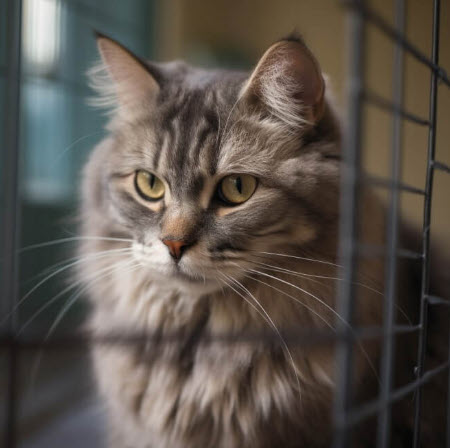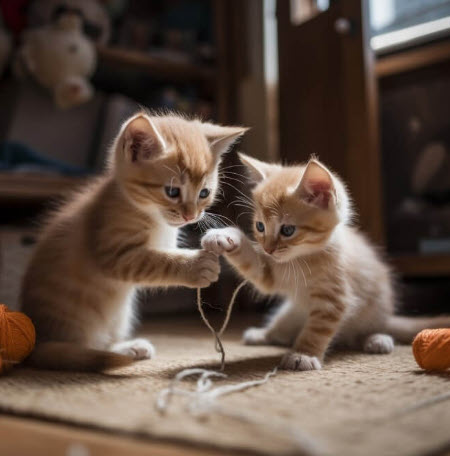Would you prefer to listen to a short podcast discussion about this article? Click on the audio below.
Introducing a new cat to your home, and perhaps to other cats, can be tricky. It requires patience and careful observation. However, failure to introduce cats properly can lead to fights, stress, and anxiety in both cats. Therefore, it is crucial to recognize the ten warning signs indicating the introduction process is not going well. In this interesting article, we will discuss in detail these warning signs.
Table of Contents

Warning Signs When Introducing a New Cat to Your Home
The first warning sign is growling or hissing. When cats are introduced, it is common for one or both cats to growl or hiss as a warning sign to the other cat. This behaviour alerts the other cats that they are unhappy with their presence. Awareness of this behaviour and giving the cats ample space to calm down is essential.
The second warning sign is a puffed-up tail. When cats are upset or afraid, they tend to puff up their tails to appear more significant than they are. This body language is a sign of aggression or fear, so it is best to give the cats space to adjust to each other.
The third warning sign is nervousness. Cats are very intuitive creatures who can sense when something is off. So if one of the cats is acting nervous or tense, it may be a sign that the introduction process is not going well.
The fourth warning sign is excessive grooming. When a cat is anxious or stressed, it may groom itself excessively. If you notice one of the cats grooming itself more than usual, it may be a sign of stress and discomfort.
The fifth warning sign is hiding. A cat hiding or avoiding the other cat indicates they are uncomfortable with the situation. Again, allowing the cats to adjust to each other naturally is crucial.
The sixth warning sign is urine spraying. Male cats tend to spray urine when they are stressed, anxious, or marking their territory. If you notice urine spraying, it may be a sign that the cats need more time to adjust to each other’s presence.
The seventh warning sign is swatting or scratching. Cats may resort to physical aggression if they are uncomfortable or feel threatened. If you see one cat swatting or scratching the other, it may be time to separate the cats and try reintroducing them later.
The eighth warning sign is excessive vocalization. Cats may vocalize excessively when they are stressed, anxious, or unhappy. For example, if one of the cats is making more noise than usual, it may be a sign that they are uncomfortable with the introduction process.
The ninth warning sign is loss of appetite. Cats may lose their appetite or stop eating when anxious, stressed, or upset. If you notice one of the cats losing weight or not eating as much as usual, it may be time for you to seek professional help for your cat.
The tenth warning sign is aggression towards people. If you notice aggression towards people during the introduction process, it may be a sign that the cats are not adjusting well to each other. Therefore, it is essential to be cautious.
How to Introduce a new cat to your home

- Create a separate space for the new cat.
Before bringing the new cat home, have a separate room where the cat can stay for several days. This will allow the new cat to acclimate to their new environment and prevent confrontations with any existing cats. - Use a scent-swap technique.
Cats rely very heavily on their sense of smell, so it’s important to swap scents between the cats before any face-to-face introductions are made. This can be done by swapping bedding or toys between the cats or even using a towel to rub the scent of one cat onto the other. - Allow the cats to see each other.
Once the cats acclimate to each other’s scents, it’s time to introduce them visually. Place the new cat in a carrier or behind a baby gate and let the existing cat come up and investigate. This will allow both cats to see and smell each other without physical interaction. - Gradually increase interaction time.
After several short sessions of supervised interaction, gradually increase the time the cats spend together. Keep a close eye on your cats’ body language during these interactions. If they seem tense, separate them and try again later. - Give each cat its own space.
Once the cats are comfortable spending time together, you must give each cat their space. This can be achieved by providing separate food and water dishes, litter boxes, and beds. In addition, provide plenty of vertical space, such as cat trees or shelves, where each cat can perch and feel safe. - Don’t rush the process.
It’s important to remember that introducing cats can take time, sometimes several weeks, and it’s important not to rush the process. Each cat is unique and will need their own amount of time to adjust to a new cat in the household.
Introducing a New Cat to a Dog
Introducing a new cat to a dog can be a gradual process. Here are some steps to follow:
1. Allow the animals to get familiar with each other’s scent: Keep the animals separated but allow them to smell each other’s bedding or toys to get familiar with each other’s scent.
2. Start with a visual introduction: Allow the animals to see each other through a baby gate or in separate rooms.
3. Supervised interactions: Gradually increase the amount of time the animals spend together under supervision. Reward both the dog and cat when they interact positively.
4. Avoid forcing interactions: Do not force the animals to interact if one or both of them are scared or aggressive.
5. Offer separate spaces: Make sure the cat can access areas the dog cannot reach, like high shelves and rooms with baby gates.
6. Reward good behaviour: Reward both the cat and the dog for positive interactions. Following these steps can help ensure a smoother introduction between your new cat and dog.
Conclusion
In conclusion, introducing cats properly can prevent many problems and ensure a successful and peaceful coexistence. Following these steps and being patient with the process can help your cats become best friends.
Help support the Cats Protection League with a monthly donation
If you require any assistance with this article, please do not hesitate to Contact Us




















